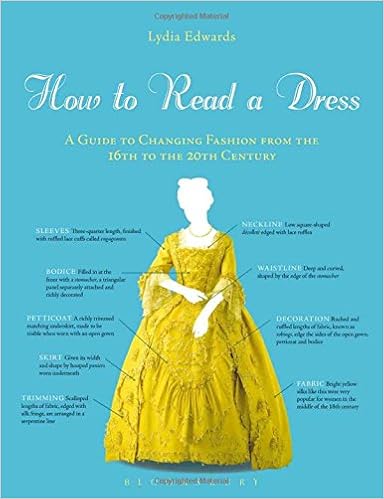How to Read a Dress by Lydia Edwards
This book is basically an illustrated timeline of western dress, with an emphasis on the "dress". It doesn't really delve into material culture theory or methodology (like The Dress Detective) or the specifics of a particular era, or go into lots of detail. Instead, it's a succinct visual overview of changing silhouettes and styles. The book is arranged chronologically, not divided by region, and focuses only on women's dresses--accessories are only incidentally addressed, while men's and children's fashions are not covered. The commentary is decidedly subordinate to the pictures: while not being left to "speak for themselves", the commentary accompanies the pictures, rather than the pictures illustrating the discussion.
The book is divided into 11 chapters, based on silhouette: the shortest covers a mere 11 years (1918-1929), the longest, almost a century (1610-1699). Each starts with a few pages discussing the popular materials, stylistic trends, and the particular foundation garments in use during that time, liberally illustrated with a mix of portraits, advertisements, fashion plates, and photographs of surviving garments. After the introduction comes 4-12 original garments with commentary. These pages follow the cover design: each dress takes up about 3/4 of a page, with 6-12 comments of 1-3 sentences each, and a short (2-3 sentence) description above. Most examples have a second, inset picture related to the main one--a detail shot, a contemporary accessory, or an old photograph of the dress being worn. Once or twice, a second, full-page image is also included.
I think the strength of this book lies in the many examples--69 featured dresses and extras included in the introductions--and in its neat, chronological organization. Between the examples and the glossary, I think this books is a valuable tool for developing the vocabulary to discuss different fashion eras. I'm also impressed at how much information does end up being included in the single-page allotted to each garment, though I wouldn't mind if the page sizes (and pictures) were larger. Most dresses only have a single picture, but I think the varied use of side-on, front-on, and 3/4-front views allow each dress to be shown to its best advantage. I do wish, however, that the rare two-image dresses used different views*. I think the comments do a good job of pointing out each dress's unique attributes and suggesting topics for further study, without derailing the overall flow of the work.
If you're focusing on a narrow time frame or eager for lots of detail, this probably isn't the book you want. It's worth a chance if you're interested in long-term dress trends, moderate amounts of detail, and/or historic eye candy.
*To be fair, one of the dresses does have a front and back view.
Stars: 4 stars.
Accuracy: High. The pictures are all original dresses--with some original portraits to round out the earlier years--and most of the commentary is annotated. Occasionally, there's a remark or generalization that I would liked to have found a note for, but that's pretty rare.
Strongest Impression: This book is pretty, interesting, and has a lot going for it. I think it does a good job of balancing the level of detail with the scope of the topic, and successfully delivers a thorough, tidy look at four centuries of western dress(es).
Bonus: The cover dress!

No comments:
Post a Comment
Thanks for commenting!